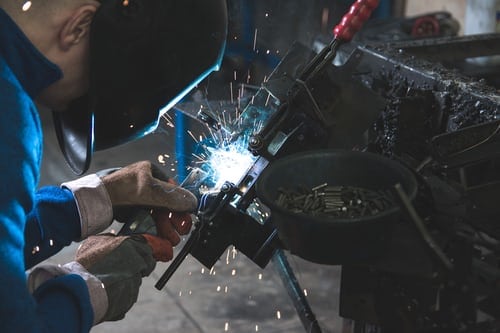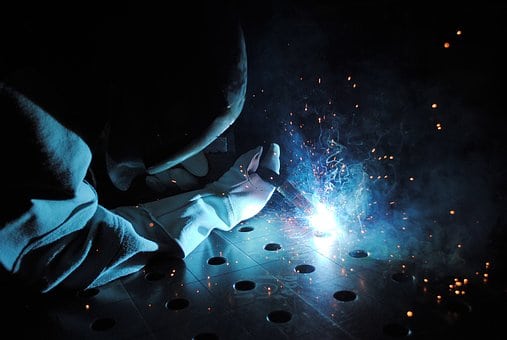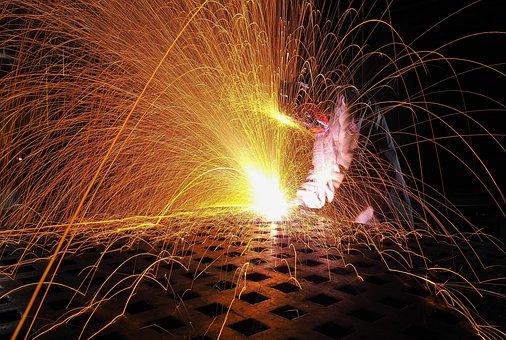
Table of Contents
What is metal fabrication?
Metal fabrication is the process of building machines and structures from raw metal materials. The process includes cutting, burning, welding, machining, forming, and assembly to create the final product.
Most custom metal fabricated products are crafted from a range of commonly used metals and their alloys. Some of the most popular metal types available for custom metal fabrication include aluminium, brass, copper, gold, iron, nickel, silver, magnesium, tin, titanium, and various grades of steel. Fabricators often start with stock metal components, such as sheet metal, metal rods, metal billets, and metal bars to create a new product. For example, an aluminium billet may be fabricated into a curved aluminium tube by using the extrusion process and then folding the tube.
Metal fabrication projects include everything from hand railings to heavy equipment and machinery. Specific sub-sectors include cutlery and hand tools; architectural and structural metals; hardware manufacturing; spring and wire manufacturing; screw, nut, and bolt manufacturing; and forging and stamping. Metal fabrication company
The main benefit of metal fabrication shops is the centralization of these many processes that are often required to be performed in parallel via a collection of vendors. A one-stop metal fabrication shop helps contractors limit their need to work with multiple vendors to complete complicated projects.
How Is Metal Fabrication Performed?
Metal fabrication industry has broad applications across a great many industries and consumer products. Standard raw materials used include plate metal, fittings, castings, formed and expanded metal, sectional metal, flat metal, and welding wire.
Shops employ many different experts, including welders, ironworkers, blacksmiths, boilermakers, and similar professionals that work with these raw materials and convert them into their final products.
According to the Bureau of Labor Statistics, approximately 1.425 million workers are employed in metal fabrication. Among them are cutting, punching, and press machine setters and operators; first-line supervisors; managers; machinists; team assemblers; welders, cutters, solderers, and brazers.
Sector Characteristics
Because the economy drives demand, the profitability of the metal fabrication industry relies on economic growth to thrive. Since the economic rebound after the last recession, metal fabrication has become a strong and intense business that continues to recalibrate itself and flourish. Current adjustments include a shift from leaning on a few large projects to maintain a yearly profit to attempting to manage steady sales volumes by diversifying and continuing to follow the successful template of previous years.
Most companies in the metal fabrication business work primarily to fortify their organization's strategy in a manner that can best help them make it through changes in the global economy. When the local economy thrives, these boosts tend to cause consumers to loosen their purse strings and purchase bigger-ticket items such as cars, boats, and houses. And as the population continues to grow, new construction picks up, requiring additional agricultural and commercial machinery.
The metal fabrication industry is highly cyclical and depends on industries such as auto, aerospace, construction, and energy. Earnings for each sector vary based on market and economic factors affecting those markets. Investors must look at their particular customer base and the economic influences affecting them in any given year.
To gather the best predictions, metal fabricators can start by looking at significant statistics for that area of business, be it home construction, energy, defence, or any other area. By diversifying the customer base and collecting customers from a variety of sectors, the cyclical nature of the industry can better manage to keep net profits consistent.
Metal fabricators that can quickly shift product lines can protect profits and focus on areas where demand is most prevalent. This type of diversification can create a sustainable revenue base, regardless of revolving economic conditions.
What are the Benefits of Metal Fabrication Shops?
The main benefit of metal fabrication shops is the centralization of these many processes that are often required to be performed in parallel via a collection of vendors. A one-stop metal fabrication shop helps contractors limit their need to work with multiple vendors to complete complicated projects.
What does the metal fabrication process look like?
Though most metal fabrication indeed focuses on the cutting and shaping of metal, there are several steps typically involved in a successful fabricated project. The fabrication process starts with a design and ends with a finished and functional part. Here's a brief breakdown of the steps included in a typical fabrication project.
Designing the Project: The first and most important step in the design of the part/product. Many businesses come to us with a completed design; however, some come to us with a prototype, in which case, we work with them to refine and test the design before starting a large run. Most Metal fabricators use computer-aided design programs (CAD) or computer-aided manufacturing (CAM) during the manufacturing process. Using CAD and CAM programs, we're able to develop a 3D prototype of an object before we actually begin to work with the metal.
Considering that a project can include many components, this phase helps to ensure that the product will function as required. During the design process, we'll also work on clarifying the types of metal that will be used and the finishing process that's required.
Fabricating the Part: The second step in a metal fabrication job encompasses the actual building process. During this phase, a metal fabricator cuts and shapes each of the components from the design phase. There's a wide range of tools used in these projects-- you can view our machinery and capabilities here. For every unique process, there is a machine-specific machine used to carry out that process. For instance, on any given job, a metal fabricator might be required to use a laser cutting, press brake, or roll forming equipment. Since each project is different, the equipment required for that project will also be different. Fortunately, CAMM Metals operates in a 17,000 sq foot facility stocked with state-of-the-art equipment. View this page to get an idea of the machines that are spread throughout our facility. We often employ CNC tools (computer numerical controls) to ensure that each piece is cut exactly to the specifications from the design. These tools extract a computer program of the exact commands and specifications used to create a piece.
Assembling and Finishing the Project: The last step in metal fabrication is finishing and assembling the pieces into the final product. In essence, these processes help to strengthen the product and ensure that it's ready for its intended use. Finishing techniques like deburring help to make sure that materials function properly and have no excess material. Beyond that, we can powder coat the product to ensure that it's aesthetically pleasing (if this is necessary).
Metal fabrication is a critical part of the manufacturing process. From paperclips to plane parts, it's used to create a wide variety of products. Metal fabrication is an essential step in creating everything from hardware and tools to car parts and pipes. Fabricated metal products accounted for $345.1 billion of shipments in 2013 alone!
Although fabricated metal products are common, few people understand how the metal fabrication process works. Most people think of welding when they hear metal fabrication. But welding is just one process that metal fabricators use.
Metal fabrication is a manufacturing process used to shape metal into parts or end products. We use a number of techniques to form sheet metal into a part or good.
Check out Austgens METAL ROLLING
Most metal fabrication uses sheet metal, which can be up to .25 inches thick. Fabricators convert this sheet metal into products or tools. We cut, stamp, fold, or shape metal to create the finished part.
Some examples of products made with metal fabrication include:
- Hand tools
- Bolts, nuts, and screws
- Cans
- Cutlery
- Pipes and pipe fittings
- Metal windows and doors
- Equipment attachments
- Car parts
Metal fabrication plays a large role in creating parts for mass consumption. The mass production of products like screws, cans, cutlery, pipes and pans all fall into this category. These products tend to have consistent requirements and a wider tolerance for error. This means that the parts can differ in small ways from the original design but still function as expected.
On the other hand, metal fabrication can also create large runs of customized fabricated metal products. These projects usually include the design and fabrication of customized metal parts to fit a business' needs. Customized valves, car parts and hardware, are all examples of this type of project.

What should a future look like with metal fabrication?
The industry is learning to balance capacity with variability and find new ways to build support for the inherent variability of customer demands that are driven by an ever-changing economy. As machinery becomes more sophisticated, the ability to maintain a constant level of capital and profit is improving.
Although forecasting can be difficult in a business dependent on the economic fortune of its customers, the general consensus remains that those who can keep up with rapidly changing demands while still maintaining a high output capacity will elbow into a position of maximized profits.
How much is the capital in metal fabrication?
To maintain profitability, metal fabrication shops require capital to quickly adjust output and meet the demands of a diverse customer base. Covering costs is easy in a booming economy. Still, when belts tighten, the industry must begin to cut corners and reduce variable costs, which in turn naturally limit the customer base the shop is able to cater to at any given time. The ability of these companies to make new investments that allow them to maintain a variable output is the key to sustaining customer diversification.
By pairing efforts to diversify their customer base with economic vigilance and an eye on competitor costs, as well as ensuring the entire manufacturing process is streamlined from top to bottom, fabricators can protect their investments from the impacts of negative environmental influences.
The metal fabrication industry stands as a solid investment built on highly fluid customer demand. This lucrative moving target can be difficult to pin down, as shops struggle to gear their efforts and capital toward those sectors that yield the highest profits at any given time.
The volatility of the market has required the industry to streamline production practices and focus on the ability to produce high-capacity output for many different customer requests reliably.
Those metal fabricating shops that can optimize their manufacturing process and operating machinery, paired with stakeholders who can pay close attention to competing costs and the economic trends affecting their customer base, will lead the industry.
What industries use metal fabrication?
Metal fabrication has applications in a wide variety of industries. Because of the versatility of tools and processes, it's used to create parts for industries as varied as agriculture, spa furniture and cars.
Some of the industries that use metal fabrication include:
- Aerospace
- Agricultural industries
- Alternative energy
- Automotive
- Construction
- Consumer products
- Military and defence
- Original equipment manufacturers
- Recreational vehicles
Fabrication is often associated with automotive and heavy equipment industries. It's used to make a variety of car parts, from engine components to caps and valves. We also manufacture components for planes.
But metal fabrication doesn't always mean small components. We also cut and join large pieces for tanks and transport vehicles.
Metal fabrication for the is on the other end of the spectrum. In the construction and agricultural industries, durability and strength are essential. Metal fabrication applied to heavy-duty materials has applications in pilings, tractors and heavy equipment attachments.
Check out Aluminium Welding: How to Weld Aluminium
What are the techniques in metal fabrication?
Metal fabrication is a complicated process. It takes many techniques to create customized metal parts. Knowing more about the techniques that a metal fabricator uses can help you find the right fabricator for your needs.
Reduction Processes
One of the most common metal fabrication processes is reduction techniques. These processes remove parts of the metal to create a correctly sized and shaped piece.
Shearing reduces metal pieces to the correct size or shape. It's commonly used on aluminium, steel, stainless steel, brass or bronze. Shearing is most suitable for flat sheet metal.
In shearing, a stationary blade holds the metal in place—a movable upper blade slices through the metal from above. Blades mounted at an angle to produce diagonal cuts. Shearing only produces straight lines but can create a variety of shapes.
Punching: Used to place holes in sheet or rolled metal, punching is most suitable for high volume production.
Punching involves a hardened metal punch placed above the metal and a die beneath it. The punch produces a slug of metal within the hole, which is usually recycled. Punching helps to remove excess material from the work surface.
Blanking is used to create metal workpieces for medium and high production workloads, blanking is best for sheet or strip metal, and is more suitable for softer metals like aluminium.
During the blanking process, machines force a punch through the metal into a die. The piece that's cut out during blanking is the new work surface. The material produced by blanking is usually larger than that produced by punching and usually undergoes other metal fabrication processes. Manufactures usually punch blanks closely together to reduce waste.
Notching: Used to create detailed cuts and angles that aren't possible with standard shearing processes, notching can be used on a wide variety of metals. However, it is most suitable for sheet or rolled metals. It's usually lower volume than shearing.
Notching removes materials from the outside of a piece of metal. One or more blades placed at angles remove excess material from the metal. Notched materials often go through multiple rounds of notching to arrive at the final shape.
Shaping Processes
Sometimes metal needs to be shaped instead of simply cut. There are varieties of different processes used to shape metal. During the fabrication process, metal is usually cut first, then shaped.
Stamping: Stamping creates one or more raised sections of metal. Often used when fabricating medium to large batches of parts, stamping might refer to progressive die drawing, shallow stamping or deep stamping.
In stamping, metal placed between a stamp and a die creates a raised or lowered surface. Many stamping processes are relatively shallow and create a narrow surface. This is why it's most suitable for sheet or rolled metal. Used in sequence, multiple stamps or dies help create the final piece.
What are the other processes in metal fabrication?
Several other processes used during the metal fabrication process join different sheets of material together or shape large blocks of metal.
Welding is one of the most common ways to join pieces of metal. A skilled welder can extend sheet metal and join it with a number of unique joints.
There are several types of welding, including Robotic Welding, TIG and MIG welding. TIG welding, or Tungsten Inert Gas welding, is usually used when handling very thin materials or when it's important not to deform the metal. MIG welding, or Metal Inert Gas Welding, welds joints in thicker metals.
Machining: Machining, sometimes considered a separate industry to metal fabrication, actually plays a vital role in the process. However, many metal fabricators also do machining. Machining shapes blocks of metal instead of sheets or rolled metal.
Machining removes pieces of metal from the block in order to shape the final product. There are a number of tools used for machining. Lathes, mills and drills are some of the most common.
Today, CNC machining is one of the most common types of machining. CNC stands for Computer Numerical Controls. In CNC machining, lathes, drills and other tools are controlled via a computer. This makes it possible to take an electronic design and shape it directly into the metal. Check out The Ultimate Guide To Getting your Welding Certification

How to choose a metal fabrication business?
Finding the right metal fabrication shop for your project can be challenging. Asking a few questions ahead of time can help you find the right fabricator. Here are five questions you should ask a metal fabrication shop before you decide:
Does the company have the capacity for your project?
When choosing a metal fabricator, one of the first questions to answer is whether the company has the capacity to take on your project. There's a wide variety of metal fabricators in the business. Some specialize in working with just one industry. Others offer a range of services.
If your fabrication project is complicated or has a very narrow tolerance for error, look for a company that specializes in precision fabrication. If a metal fabricator serves this field, they're likely to have the skills and experience needed for other precision work.
Ask what the company's standard project size is, as well. If a fabricator specializes in individualized products, they may not have the capacity to handle larger orders quickly.
What services does the fabricator handle in-house?
It's frustrating to hire a fabricator only to realize that some of their services are outsourced. The unfortunate reality is that many fabricators do outsource steps of the design or finishing process.
Before selecting a metal fabricator, ask which services they offer and whether they outsource any of them. Does staff handle all of the building and fabricating steps? What is their experience in the field?
It can also be helpful to ask about support during the design process. Can you work with engineers at the company to modify your design if necessary?
Some customers come to us with a complete computer rendering and prototype. Others want to test and modify designs before manufacturing a large run. Our in house engineering team can work with these customers to modify designs and offer suggestions on how to obtain a higher quality part.
How many staff does the company have, and what is their experience?
Experienced staff is critical for a successful metal fabrication project. Ask potential partners about the size of their staff and what experience they have in the field.
We recommend looking for businesses that have certified engineers and welders on staff. Certification provides proof that the staff has the experience and skill necessary to complete your project successfully.
What does the project bid include?
It's common to get several bids when shopping for a metal fabricator. But not all bids provide the same information. When comparing bids from fabricators, make sure you understand exactly what's included in the proposal.
Some of the things to look for in a bid include:
- The services the business will perform
- Whether modifications are included in the proposal
- An estimate of how long the project will take
- The cost of materials
- Who is responsible for sourcing materials
It can also be helpful to ask the business whether they've padded their bid and if so, by how much. Most project proposals include some padding to account for any problems that might come up during the project, from modifying part of the design to sourcing materials.
Can the company source materials and complete jobs on time?
Some of the best fabrication businesses, like Summit Steel, call the USA home. If you'll be fabricating parts for use in the States, finding a fabricator based in the US can make a big difference. It will reduce shipping time and costs, and cut down on problems with sourcing materials.
You may want to find out whether the fabricator has a warehouse or factory near your company, particularly if you'll be fabricating large or heavy parts.
The location of suppliers, and a company's relationship with them, is also important. If a shop has a good relationship with their suppliers and pays their bills on time, they're more likely to be able to source materials easily. This is particularly important if your parts will require less common metals.

